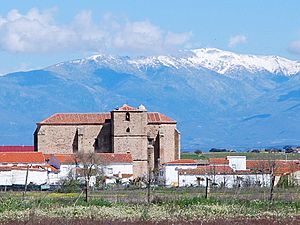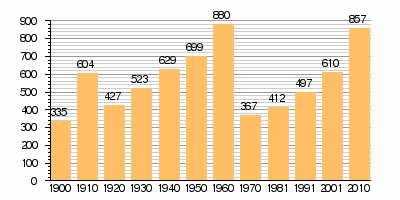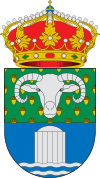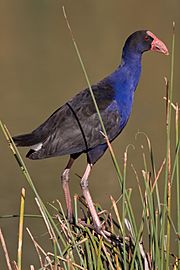Saucedilla facts for kids
Quick facts for kids
Saucedilla
|
||
|---|---|---|

Church of St John the Baptist, Saucedilla with the Sierra de Gredos snow-covered behind
|
||
|
||
| Country | Spain | |
| Autonomous community | Extremadura | |
| Province | Cáceres | |
| Comarca | Campo Arañuelo | |
| Municipality | Saucedilla | |
| Area | ||
| • Total | 60 km2 (20 sq mi) | |
| Elevation | 258 m (846 ft) | |
| Population
(2018)
|
||
| • Total | 858 | |
| • Density | 14.3/km2 (37.0/sq mi) | |
| Demonym(s) | naveros | |
| Time zone | UTC+1 (CET) | |
| • Summer (DST) | UTC+2 (CEST) | |
| Website | http://www.saucedilla.es | |
Saucedilla is a small town in the province of Cáceres, located in the Extremadura region of Spain. It is part of the Campo Arañuelo area, with Navalmoral de la Mata as its main town. In 2010, about 859 people lived there.
Contents
Exploring Saucedilla's Nature and Surroundings
Saucedilla is in a beautiful spot. To the north, you can see the huge Sierra de Gredos mountains and the Tiétar River. To the south and west are the Miravete Sierra, the Tagus River (called Tajo in Spanish), and the Serrejón Sierra. The weather here is like the Mediterranean, with warm, dry summers and mild, wet winters. The town sits on a large, flat area with clay soil.
What is a Dehesa?
The area around Saucedilla is full of large dehesas. A dehesa is a special kind of forest. It has scattered holm oaks or cork oaks. These trees provide shade and food for animals.
Farmers here raise different animals:
- Cattle
- Sheep (for meat and wool)
- Goats (for meat and cheese)
- Pigs, especially Iberian pigs, which are used to make famous hams like jamón ibérico and jamón serrano.
You can also find farms that raise fighting bulls (called toro bravo). Some of these farms, known as ganaderías, are right in Saucedilla, like Cerro Alto and La Anguila. Others are in nearby villages.
The Arrocampo Reservoir: A Special Lake
The Arrocampo Reservoir was built in 1976. Its main job is to cool the machines at the Almaraz nuclear power plant, which is close to Saucedilla. Water from the Tagus river flows through a system of dams and dikes. This creates an 11-kilometer (about 7-mile) loop that helps cool the power plant's turbines.
This reservoir is full of life:
- Tiny Life: It has lots of phytoplankton (tiny plants) and zooplankton (tiny animals). This is because the water is rich in nutrients and has good oxygen levels.
- Plants: The most common plant here is the bulrush (Typha latifolia). These plants create a great home for birds and small mammals.
- Fish: You can find different types of fish, like barbels (Barbus barbus), common carps (Cyprinus carpio), tenches (Tinca tinca), and large largemouth bass (some almost 50 cm long!).
Today, the Arrocampo Reservoir is a very important Special Protection Area (SPA) for wild birds. Many birds, both those that live here all year and those that migrate, can be seen. Some of these birds include:
- White stork (Ciconia ciconia)
- Lesser kestrel (Falco naumanni)
- Purple heron (Ardea purpurea)
- Squacco heron (Ardeola ralloides)
- Black-crowned night heron (Nycticorax nycticorax)
- Little bittern (Ixobrychus minutus)
- Osprey (Pandion haliaetus)
- Cattle egret (Bubulcus ibis)
- Great cormorant (Phalacrocorax carbo)
- Purple swamphen (Porphyrio porphyrio) – This bird is often seen as the symbol of the Arrocampo Reservoir SPA.
Cañada Real Leonesa Occidental: An Ancient Sheep Trail
Saucedilla has always been a place for sheep. The town's coat of arms even shows a ram's head! For hundreds of years, Extremadura (where Saucedilla is) was a key area for moving large flocks of sheep. This movement, called transhumance, was very organized in medieval Spain by a system called the Mesta.
These long journeys for sheep and cattle happened on special paths. In Castile, they were called cañadas reales. The Cañada Real Leonesa Occidental (Western Leonese Royal Droveway) passes through the south of Saucedilla, near the cemetery. There's even a country house near the graveyard that shepherds and cowherds still use today when they travel along this old path.
Farming in Saucedilla
For a long time, Saucedilla's economy was all about traditional farming. Farmers grew crops without irrigation, just relying on rain. They also raised sheep, goats, cattle, and pigs. For many years, the lands of Saucedilla produced cereals like wheat, barley, oats, and rye. They also grew chickpeas, broad beans, and root vegetables like turnips, along with olives and grapes for wine.
Things changed in the 1980s with new irrigation farming. The Valdecañas Reservoir on the Tagus River (southeast of Saucedilla) and many new channels brought water to the farmlands. Now, farmers can grow different crops, like fodder for cows and sheep, and fruits such as tomatoes, pimientos, bell peppers, and peaches.
Special Protection Areas for Birds
Saucedilla is home to two Special Protection Areas (SPAs), which were created in 2005 to protect wild birds.
- Arrocampo Reservoir Special Protection Area: As mentioned, this area is a haven for a huge variety of wild birds.
- Lesser Kestrel Colonies of Saucedilla Special Protection Area: This special area is located right on the parish church of Saucedilla! In 2005, 17 pairs of lesser kestrels (Falco naumanni in Latin, cernícalos in Spanish) were found nesting in the holes in the church walls.
Arrocampo Ornithological Park: Bird Watching Fun!
If you love birds, you'll enjoy the Arrocampo Ornithological Park. It has two special routes for bird watching, marked with wooden signs. There's also an Information Office near the town's swimming pools at the south entrance.
- Route 1: Arrocampo Reservoir Route: This path has 4 special spots (bird hides) where you can quietly watch birds without disturbing them.
- Route 2: Cerro Alto Route: This route has 1 bird hide.
Saucedilla's Population Over Time
- Late 1400s: Saucedilla had about 900 people living there. A small group of Jewish people also lived in Saucedilla before they were asked to leave Spain in 1492.
- 1528 to 1653: The town's population went down a lot during this time, which was a period of big population changes across Spain.
- 1960s: Many people and their families left the village in the early 1960s. They moved to bigger cities like Madrid, Barcelona, and Bilbao, or even to countries like France and Germany, to find work.
- Today: There is a community of Moroccan people living in Saucedilla. They often work in farming, helping with tobacco, harvests, and fruit picking, or in domestic service.
Here's how the population changed from 1900 to 2010:

A Look at Saucedilla's History
- 1300s: Saucedilla was founded in the middle of the 14th century. People from a small village called Collado de la Vera, located in the foothills of the Sierra de Gredos mountains, started the town.
- 1400s: The town grew and developed during this century.
- 1500s: The main church was built. It combines Gothic and Renaissance styles. Its construction began under Bishop Gutierre de Vargas Carvajal and finished when Pedro Ponce de León was bishop.
- 1600s:
- Francisco Tuttavilla became the Lord of Saucedilla.
- The jurisdiction column (rollo jurisdiccional in Spanish) was built. This column showed that the town had its own local government.
- 1700s: The County of Saucedilla was created, and the town had its own Counts.
- The Independence War: Saucedilla also played a part in Spain's War of Independence.
Important Monuments to See
Saucedilla has some interesting historical buildings and structures.
- St John the Baptist Church: Built in the 1500s, this church shows off both Gothic and Renaissance styles.
- Jurisdiction Column: This column from the 1600s is a symbol of the town's old legal power.
- Plasencia Cross: Another historical landmark in the area.
Images for kids
-
A Squacco heron (Ardeola ralloides) at Arrocampo Reservoir
See also
 In Spanish: Saucedilla para niños
In Spanish: Saucedilla para niños

















